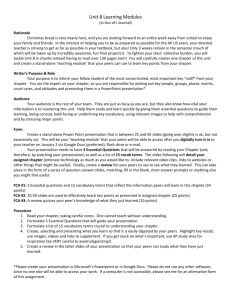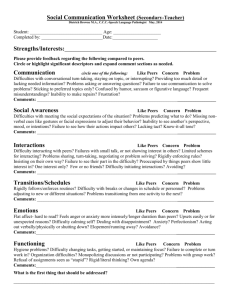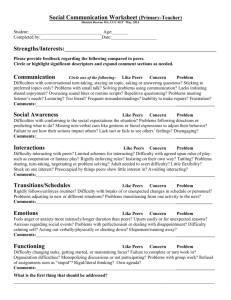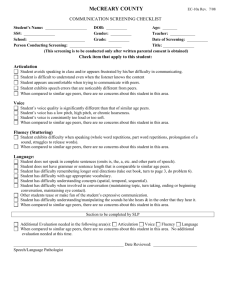Communication & Interaction Checklist
advertisement
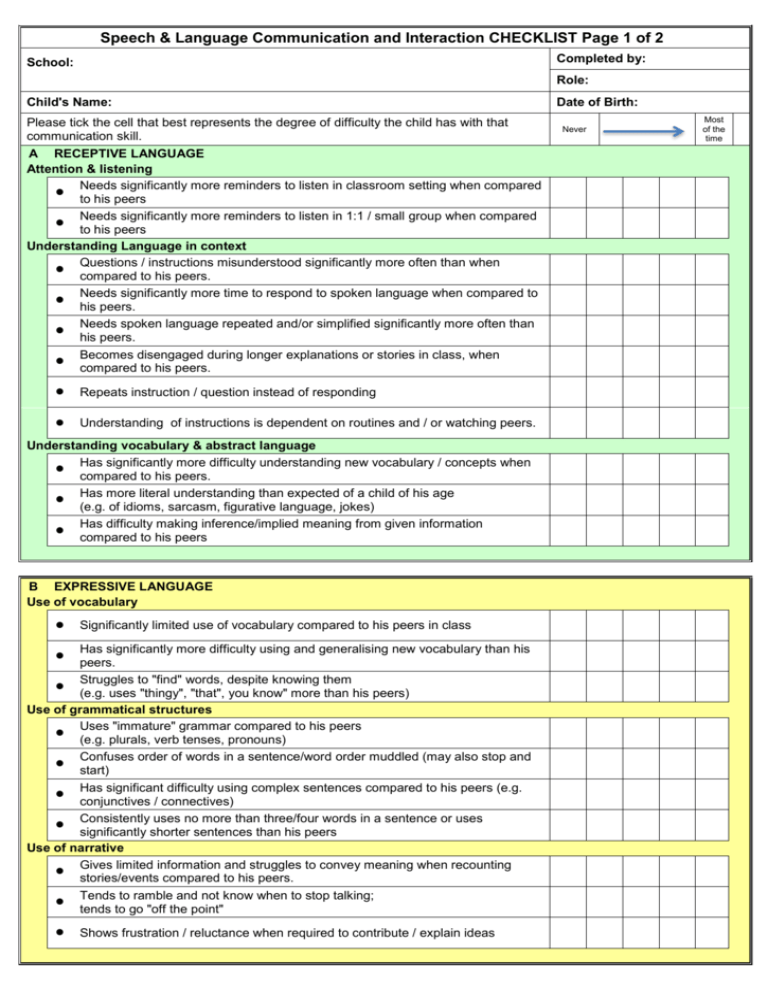
Speech & Language Communication and Interaction CHECKLIST Page 1 of 2 Completed by: School: Role: Child's Name: Please tick the cell that best represents the degree of difficulty the child has with that communication skill. A RECEPTIVE LANGUAGE Attention & listening Needs significantly more reminders to listen in classroom setting when compared to his peers Needs significantly more reminders to listen in 1:1 / small group when compared to his peers Understanding Language in context Questions / instructions misunderstood significantly more often than when compared to his peers. Needs significantly more time to respond to spoken language when compared to his peers. Needs spoken language repeated and/or simplified significantly more often than his peers. Becomes disengaged during longer explanations or stories in class, when compared to his peers. • • • • • • • • Date of Birth: Most of the time Never Repeats instruction / question instead of responding Understanding of instructions is dependent on routines and / or watching peers. Understanding vocabulary & abstract language Has significantly more difficulty understanding new vocabulary / concepts when compared to his peers. Has more literal understanding than expected of a child of his age (e.g. of idioms, sarcasm, figurative language, jokes) Has difficulty making inference/implied meaning from given information compared to his peers • • • B EXPRESSIVE LANGUAGE Use of vocabulary • • • Significantly limited use of vocabulary compared to his peers in class Has significantly more difficulty using and generalising new vocabulary than his peers. Struggles to "find" words, despite knowing them (e.g. uses "thingy", "that", you know" more than his peers) Use of grammatical structures Uses "immature" grammar compared to his peers (e.g. plurals, verb tenses, pronouns) Confuses order of words in a sentence/word order muddled (may also stop and start) Has significant difficulty using complex sentences compared to his peers (e.g. conjunctives / connectives) Consistently uses no more than three/four words in a sentence or uses significantly shorter sentences than his peers Use of narrative Gives limited information and struggles to convey meaning when recounting stories/events compared to his peers. Tends to ramble and not know when to stop talking; tends to go "off the point" • • • • • • • Shows frustration / reluctance when required to contribute / explain ideas Speech & Language Communication and Interaction CHECKLIST Page 2 of 2 Child's Name: Most of the time Never C SPEECH • • • Very difficult to understand, compared to his peers, even for familiar adults Difficult to understand in connected speech Persistent difficulties with saying polysyllabic words D INTERACTION • • • • • • • Reluctant to interact with other children Inappropriate use of "non-verbal" communication (e.g. eye contact, facial expression, personal space) Difficulties starting and sustaining a conversation compared to what is expected of a child of his age Prefers to interact with younger peers Unaware of social rules appropriate to his age Isolated play/finds it hard to join in games with his peers Poor imagination E BEHAVIOURS FOR LEARNING • • • • • • • Difficulty with organising and starting tasks when compared to peers Difficulty persisting with tasks that present a challenge Has difficulty concentrating when compared to peers Has poor self-awareness in relation to learning when compared to peers Is unable to work independently on tasks Shows little interest in learning when compared to peers Difficulties appear to impact on self esteem State Child's Strengths: Comments: e.g. Additional medical diagnoses/social and emotional difficulties, which may impact on the above scores, if not recorded on the request for information sheet. Communication & Interaction Checklist Version September 2015


